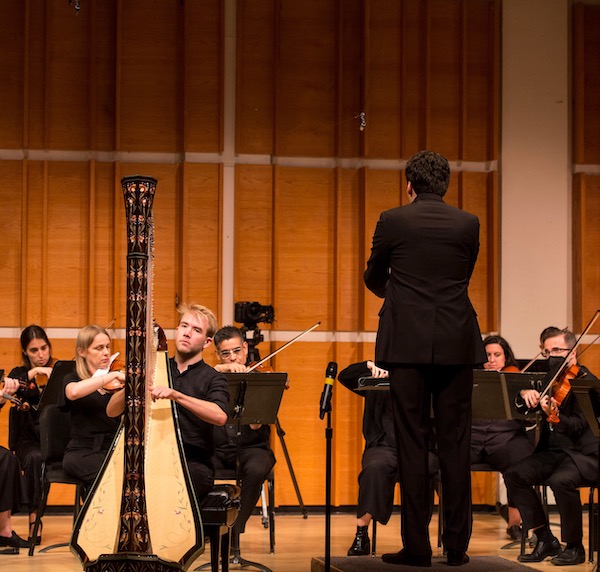Parlando program impressively explores the “Sacred and Profane”

Conductor Ian Niederhoffer has accomplished two impressive feats by the age of 25. First, he has established, Parlando, a chamber orchestra, and secondly, he has found an audience.
Merkin Hall was filled to capacity for its opening concert of the season titled “Between Sacred and Profane.” The latter of the two proved the most impressive and proof that his talent and entrepreneurship are on par with his ambition.
There were no printed program notes for the concert. Rather, Niederhoffer provided insights into the broad arc of the themes that inspired the concert—the sacred and the profane —as well as background information on each of the works. He is handsome, charismatic, enthusiastic and articulate, which together with his undeniable skills as a musician, makes for a winning combination.
In exploring the tension between the sacred and the profane in the context of classical music, Niederhoffer turned to less doctrinaire meanings of the two words. Noting that Western classical music developed out of the music of the Church, he put the term into a broader context to incorporate all things that we as a society hold dear, not just the religious. Likewise, he looked to an earlier meaning of profane, which meant anything that was not religious, without the connotations of blasphemous or sordid we associate with the word today.
Reena Esmail’s Teen Murta was the first work on the program. Currently, artist-in-residence with the Los Angeles Master Chorale, the Los Angeles-based composer was the Seattle Symphony’s 2020-21 composer-in-residence. Her works straddle the worlds of Indian and Western classical music.
Teen Murti Bhavani is the name of the former New Delhi residence of the first prime minister of India, Jawaharlal Nehru, which now houses a library, museum and planetarium. It is named for the three statues that stand in front of the complex. Esmail’s composition is not based on the sculptures, but takes its structure from them. Each of three musical tableaux are rooted in a specific raag, which is a melodic framework for improvisation.
The structure of Teen Murta, which Esmail compares to that of Mussorgsky’s Pictures at an Exhibition, was inspired by concerts which she attended by Hindustani musicians when she was in India. At the beginning of the concert, the performer would announce the raag to be sung or performed and immediately audience members would begin humming it, thus creating a drone to accompany the music being performed.
For being music inspired by the profane, Esmail composed a work that is highly spiritual and very beautiful. Niederhoffer led a performance in which shimmering string sound created a mystical atmosphere. The introduction and the interludes began as soft drones in which solo violin, viola and cello began to play bits of melody, engaging in a dialogue of sorts. In the tableaux, the solos soared, at times blooming gloriously into flights of ecstatic lyricism.
There was no need for Niederhoffer to provide at thematic link to the program with the next work, as the title says is all. Debussy’s Danse sacrée et danse profane was commissioned by the Paris firm of Pleyel to promote the chromatic harp, which had been invented by Gustave Lyon in 1894. The work proved to be a success, but alas not the chromatic harp. Perhaps anticipating the instrument’s future, Debussy included that the solo harp part could be played on the pedal harp, which has become the norm and was the case here with the exciting harpist Parker Ramsay as soloist.
Parker is an engaging speaker, as well as superb harpist. In discussing the differences between the chromatic and pedal harps, he also provided a personal link to the work. His mother is also a harpist who comes from a line of harpists originating with Lucile Wurmser-Delcourt—who premiered the Debussy work at the Châtelet Theatre in Paris in 1904. Originally scored for harp and string quartet, the arrangement by the renowned French harp virtuoso Carlos Salzedo was performed.
Parker’s playing transfixed the audience with its compelling mix of delicacy and vigor. Niederhoffer maintained a perfect balance through the contrasting two parts of the work, which Debussy described as having the contrasting qualities of gravity and grace. There were moments of pure bliss throughout in which the arabesques of the harp seemed to float above gentle waves of string sound.
The final two works on the program were by Beethoven, string arrangements of the Cavatina from String Quartet No. 13 Op. 130 and the Grosse Fuge Op. 133. Niederhoffer told the audience that for many, the Beethoven string quartets are almost sacred for their place at the summit in the canon of Western classical music. Niederhoffer introduced the profane into the two works by performing them in arrangements for string orchestra, something at which purists, he added, would most certainly bristle.
Niederhoffer led a performance of the Cavatina that was beautiful, tender, and flowing. As a conductor, his style is primarily marked by economy of gesture and elegance. The Grosse Fuge brought out his more dynamic and dramatic qualities, as he sliced through the air with his arms compelling the orchestra to play ever more fiercely. The structure of the work was ever present, but it was the emotion that ruled in this performance of one of the most musically and technically challenging works in the canon.
For an encore, Parlando performed Massenet’s Le Dernier Sommeil de la Vierge. Soft, sentimental and luminous, this was music that for many is of one with the sacred.
Parlando presents “Heroines and Heretics” featuring the music of Julius Eastman, Hildegard von Bingen, and Rodion Shchedrin November 6 at Merkin Concert Hall. kaufmanmusiccenter.org







Posted Sep 30, 2022 at 2:21 pm by Saul Davis Zlatkovski
Carlos Salzedo did edit the solo part of the Debussy Danses, and he did create a version for harp and string quartet that took elements from the double-bass part and added them to the quartet parts, but the original scoring is for harp and string ORCHESTRA, not string quartet.